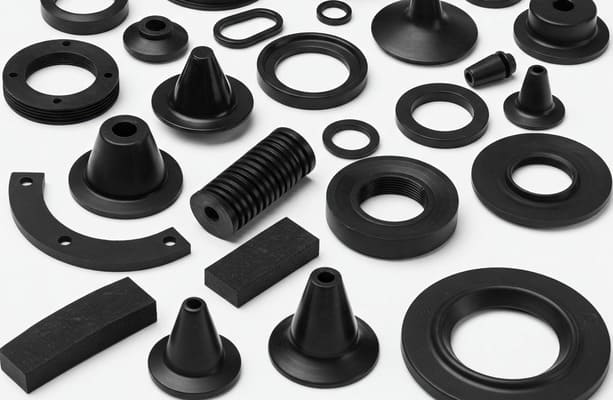Is synthetic rubber capable of replacing natural rubber entirely? This is a common question in industries that rely heavily on rubber products. While synthetic rubber offers many advantages, it still has some limitations compared to natural rubber.
Synthetic rubber can replace natural rubber in many applications, but there are still certain areas where natural rubber outperforms synthetic alternatives due to its unique properties, such as higher elasticity and superior resilience.

Let’s explore the differences between synthetic and natural rubber, and the advantages and limitations of each material.
Why Is Synthetic Rubber a Viable Replacement for Natural Rubber?
Synthetic rubber1 is made through polymerization of petroleum-based monomers, and it is designed to imitate the properties of natural rubber2.
One of the key benefits of synthetic rubber is that it can be engineered to meet specific performance requirements, such as improved resistance to heat, chemicals, and oils. This makes synthetic rubber an excellent choice for applications where natural rubber may fall short, such as in automotive parts or industrial seals.
Advantages of Synthetic Rubber
| Property | Synthetic Rubber ✅ | Natural Rubber ✅ |
|---|---|---|
| Elasticity3 | Good to moderate | Excellent |
| Durability | High (depending on type) | Moderate |
| Temperature Resistance | Excellent (varies by type) | Moderate |
| Chemical Resistance4 | High (oil, fuel, chemicals) | Moderate |
| Cost | Low to moderate | Moderate to high |
Synthetic rubber is engineered for specific applications, which makes it versatile in industries like automotive, chemical processing, and industrial manufacturing.
Why Is Natural Rubber Still Important?
Despite the rise of synthetic alternatives, natural rubber continues to be a vital material in several industries.
Natural rubber offers superior elasticity, tensile strength, and resilience compared to most synthetic rubbers. It also performs better in applications requiring flexibility and stretchability, such as tires, footwear, and medical products. Additionally, natural rubber is biodegradable, making it a more environmentally friendly option.

Advantages of Natural Rubber
| Property | Natural Rubber ✅ | Synthetic Rubber ✅ |
|---|---|---|
| Elasticity | Excellent | Moderate |
| Durability | Good | High (depends on type) |
| Temperature Resistance | Moderate | Excellent |
| Biodegradability5 | Yes | No |
| Cost | Moderate to high | Low to moderate |
Natural rubber is still preferred for its high elasticity and environmental benefits, particularly in industries like automotive (tires), medical (gloves), and consumer goods.
What Are the Limitations of Synthetic Rubber?
Although synthetic rubber is versatile, it has certain limitations compared to natural rubber.
Synthetic rubber typically lacks the same elasticity and resilience as natural rubber. It also tends to have lower performance in terms of wear resistance and tear strength in specific applications, such as high-performance tires. Furthermore, synthetic rubber is not biodegradable, raising environmental concerns.
Limitations of Synthetic Rubber
| Limitation | Synthetic Rubber ✅ | Natural Rubber ✅ |
|---|---|---|
| Elasticity | Lower than natural rubber | Excellent |
| Wear Resistance | Varies by type | Excellent |
| Durability | Depends on formulation | Moderate |
| Biodegradability | No | Yes |
Synthetic rubber can replace natural rubber in many applications, but its performance may fall short in specific areas that require higher elasticity and wear resistance.
What Applications Can Synthetic Rubber Replace Natural Rubber?
Synthetic rubber has been successfully replacing natural rubber in many industries.
In applications such as tires, seals, gaskets, and hoses, synthetic rubber has proven to be a viable replacement, especially in situations where resistance to heat, oils, and chemicals is needed. Synthetic rubber is also used in automotive parts, medical devices, and consumer goods.

Synthetic Rubber in Various Industries
| Industry | Application | Synthetic Rubber Type |
|---|---|---|
| Automotive | Tires, seals, gaskets | SBR, NBR, EPDM |
| Medical | Gloves, tubing, catheters | Nitrile, EPDM |
| Consumer Goods | Footwear, elastic bands | SBS, TPE |
| Industrial | Hoses, belts, seals | NBR, EPDM, FKM |
Synthetic rubber’s ability to meet specific performance needs, such as chemical resistance and heat tolerance, has made it a suitable replacement in these industries.
What Are the Environmental Considerations of Using Synthetic Rubber?
While synthetic rubber offers many advantages, it also has environmental challenges.
Synthetic rubber is made from petroleum-based chemicals and is not biodegradable. This creates environmental concerns related to its disposal, especially in products like tires. However, advancements are being made to improve the recyclability of synthetic rubber and reduce its environmental footprint.
Environmental Impact of Synthetic Rubber
| Environmental Impact | Synthetic Rubber ✅ | Natural Rubber ✅ |
|---|---|---|
| Biodegradability | No | Yes |
| Recycling | Difficult (depends on type) | Easier (compared to synthetic) |
| Carbon Footprint | High (petroleum-based) | Lower (natural resource-based) |
Although synthetic rubber has a higher environmental impact due to its petroleum-based composition, efforts are being made to make it more sustainable.
Conclusion
While synthetic rubber can replace natural rubber in many applications, it is not a complete replacement. Synthetic rubber offers advantages such as chemical resistance, heat tolerance, and lower cost, but it lacks the elasticity and biodegradability of natural rubber. The choice between synthetic and natural rubber depends on the specific needs of the application, and in many cases, a combination of both materials provides the best solution.
🚀 Need Custom Rubber Solutions for Your Industry?
Contact Julong Rubber today or Request a Custom Quote for high-quality synthetic and natural rubber products tailored to your needs!
Explore the advantages of synthetic rubber, including its engineered properties and applications in various industries. ↩
Discover the unique benefits of natural rubber, including its elasticity and environmental advantages, that keep it relevant today. ↩
Learning about elasticity in rubber can guide you in selecting the best materials for applications requiring flexibility and strength. ↩
Understanding chemical resistance in synthetic rubber can help you choose the right materials for your projects, ensuring durability and safety. ↩
Exploring biodegradability in rubber materials highlights environmental impacts and sustainable practices, crucial for eco-friendly choices. ↩






